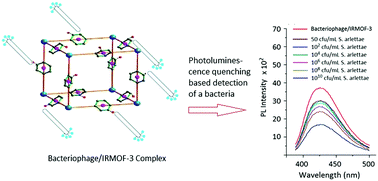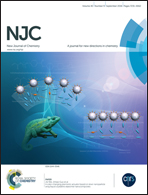Bacteriophage conjugated IRMOF-3 as a novel opto-sensor for S. arlettae†
Abstract
This article reports the novel assembly of a bacteriophage-based fluorescent sensor for the selective and sensitive detection of a model bacterium ‘Staphylococcus arlettae (S. arlettae)’. A host specific bacteriophage was bioconjugated with a fluorescence metal organic framework ‘IRMOF-3’. Changes in the photoluminescence intensities of this fluorescent probe were correlated with bacterial concentrations. The proposed bacteriophage based opto-sensor provided a low detection limit (100 cfu mL−1) along with specificity in the detection with respect to other some non-specific bacteria, e.g. S. aureus and E. coli. The detection was achieved over a wide range of bacterial concentrations, i.e. 102–1010 cfu mL−1S. arlettae. Compared to antibody and DNA based optical sensors, the use of bacteriophage in conjugation with IRMOF-3 should offer advantages of simplicity and stability. The use of IRMOF-3 as a fluorescent molecule should also offer the development of reproducible sensors because of its well defined structural geometry and hierarchical assembly.


 Please wait while we load your content...
Please wait while we load your content...